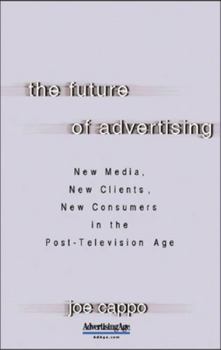The Future of Advertising: New Media, New Clients, New Consumers in the Post-Television Age: New Media, New Clients, New Consumers in the Post-Televis
Veteran industry observer Joe Cappo briefly recaps the factors that impacted the industry in the late 1990s, and gives you advice on how to best position yourself, your work, and your business.
Format:Paperback
Language:English
ISBN:0071462155
ISBN13:9780071462150
Release Date:October 2005
Publisher:McGraw-Hill Companies
Length:272 Pages
Weight:0.81 lbs.
Dimensions:0.8" x 5.9" x 8.1"
Customer Reviews
3 ratings
Advertising is the science that discovered how to quantify art.
Published by Thriftbooks.com User , 18 years ago
I don't get some of the comments (reviews listed). How can you say Cappo focuses too much on history? I wonder if anyone who thinks such a thing is really a media analyst ... I'm talking multiple regression analysis here, the past 100 years (weighted) of data that is made up of many variables and the outcome of each set. With this whe can assume a probability of what will happen before this year is out and future years (based on reasonable assumptions or trends). That's statistical history and Cappo, though not mentioning regression, is using the theory (whether it's audience size, ad budgets, etc.) Second, history is ethnography (the study of life stories of communities [generally speaking]), there is classical ethnography and there are many newer types such as usage ethnography. Sitting is people homes and watching how they watch TV etc.) If you think you know the history of advertising but you haven't used the above mentioned tools (and there are several more, sociology, psychology, women's studies etc.) THEN YOU DON'T KNOW ADVERTISING! - READ THIS BOOK! Unfortunately, if you read this book and you still don't get it, hook-up with some experts - not Joe Blow from the local print shop but Joe Cappo or someone as schooled. Alternatively, if you think you do know the history of advertising so well then why haven't you written a better book? Now for some criticisms, TV dying... I'm not sure Joe actually said that. If he did say that, I think what he really meant to say was that TV is changing. If you don't read Joe's [former] rag, Advertising Age, then you are missing out. A major company (P & G?) announced two weeks ago it was repositioning its advertising towards TV! Second, the end to commercials on TV? I actually believed without a critical thought that this was a reality. After discussing it with a colleague I was reminded of the all-time-greatest technical sore thumb, the flashing clock on the VCR. All the technology in the world isn't going to motivate someone to press more than one button. How can a society so trained in passive viewing (TV) be motivated to do more than press on, off, channel up, channel down? Fast-forward is about as complicated as most things get. But Joe seems sold on the idea that the top of the curve is going to change its behavior and enter the world of the early adopter/nerds? There needs to be a greater reward to alter behavior than not having to watch commercials. It took porn and free games to put computers or VCRs/DVDs in every household so I don't think the prospect of skipping commercials is a big enough reward for the first 95 percent of the curve. Conclusion: I'd read this book five times if I had the time. IT IS insightful, especially chapter 11. I took about 22 separate notes from this book, so if you don't have time to read the whole book then read pages 30,32,36,37,45,46,47,49,51,52, 55,56,62,64,70, 160,206,227, and 228. I loved the insightful comment comparing Survivor and Abram Maslow. If anyone
Will change but never die
Published by Thriftbooks.com User , 20 years ago
Among the many fields in the business world I think advertising comes out as one of the most dynamic. It is a business where technology and the human capacity to create go hand in hand all the time. Radio did not eliminate press, tv did not eliminate press and radio and the internet will not eliminate any of the last three. All media channels will keep working together reaching different targets or adding critical mass to each other. The main change now is a consumer who has more power to decide and to influence products and services but advertising in itself will go on and on as long as there are products and services available to sell and consumers ready to buy in the free world.
A Good Read!
Published by Thriftbooks.com User , 21 years ago
Once considered a glamorous, creative and positive influence on American popular culture, the advertising business has changed so dramatically it is almost unrecognizable today. Veteran journalist Joe Cappo uses a personal approach and an historical perspective to explain the problems advertising is facing. Two decades ago, some 20 major agencies, all independent and competing against each other, developed innovative, memorable campaigns for a variety of consumer products. But those days are over. Today, four global marketing communications holding companies control 55% of marketing expenditures. This consolidation curtailed creativity, which has resulted in agencies that produce very few memorable ads or integrated marketing efforts despite unprecedented resources. Refreshingly, Cappo does not temper his industry critique in this slightly disjointed, but well-written explanation, which is buttressed by short articles from other industry experts. Cappo sounds a wake-up call for agencies to reform themselves or lose out to more effective marketing approaches from upstart independent agencies or product manufacturers.we suggest that anyone responsible for advertising budgets or for developing marketing campaigns will benefit from Cappo's view of the past - and possible future - of advertising.





